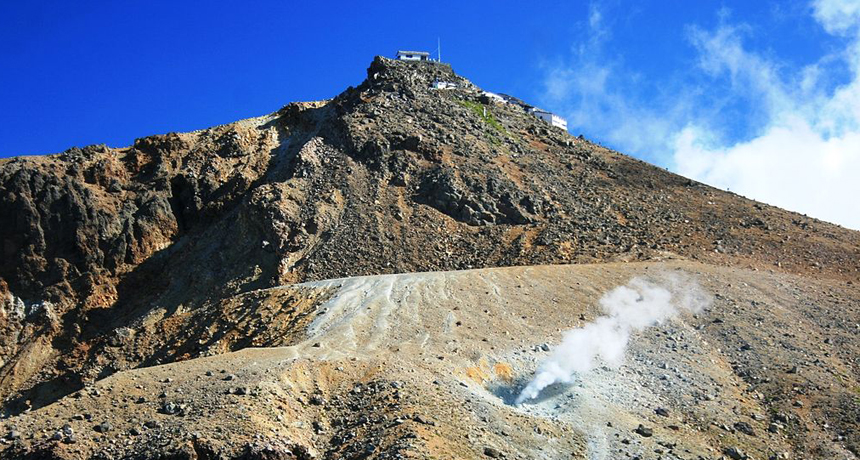News Brief: Volcano in Japan kills dozens
A surprise eruption of Mount Ontake caught hikers unawares

The summit of Mt. Ontake, Japan’s second highest peak, photographed during quieter times (August 2010). This volcano has now experienced a major — and unexpected — eruption, killing dozens.
Alpsdake/ Wikimedia Commons
By Janet Raloff
More than 250 people on September 27 were hiking on Japan’s popular Mount Ontake (On-TAHK-ay). The mountain is a volcano, but it hadn’t experienced a major eruption in decades. Suddenly, thunderous booms sounded. A cloud of ash flowed down the mountainside. An unexpected eruption had begun.
Hikers immediately began rushing down to safety. Not all made it. As of September 29, an estimated 36 people had died, according to reports from Japanese officials. The victims had confronted poisonous gases, flying rock and an intense rain of ash. That ash quickly smothered top portions of the volcano under a blanket roughly 50 centimeters (almost 20 inches) deep.
Japan’s NHK Television reported the eruption began just before noon on the southwestern side of the peak. It initially spewed large cinders across distances of up to 1 kilometer (0.6 mile), NHK reported. Volcanic gases have traveled at least three times that far.
As of late September 29, the eruption was still ongoing. The 3,067-meter (10,062-foot) volcano has erupted before. There was a small eruption seven years ago. The last major eruption occurred in 1979. Until now, though, there had never been a report of an Ontake eruption killing anyone.
Although no one had expected the new eruption, geologists knew the volcano was becoming active. Minor earthquakes began there on September 10. Those quakes were smaller, however, than ones that preceded the 2007 eruption.
Images taken by a Japan’s Daichi-2 satellite one day after the eruption started showed what appeared to be a new crater. That crater had not been visible on April 18, NHK reports.
Watch video footage captured by hikers as the volcano erupted
Power Words
ash (in geology) Small, lightweight fragments of rock and glass spewed by volcanic eruptions.
crater A large, bowl-shaped cavity in the ground or on the surface of a planet or the moon. They are typically caused by an explosion or the impact of a meteorite or other celestial body.
earthquake A sudden and sometimes violent shaking of the ground, sometimes causing great destruction, as a result of movements within Earth’s crust or of volcanic action.
fumerole A vent, often near the summit of a volcano, from which smoke and other hot gases (especially steam) escape.
satellite A moon orbiting a planet or a vehicle or other manufactured object that orbits some celestial body in space.
volcano A place on Earth’s crust that opens, allowing magma and gases to spew out from the mantle. The magma rises through a system of pipes or channels, sometimes spending time in chambers where it bubbles with gas and undergoes chemical transformations. This plumbing system can become more complex over time. This can result in a change, over time, to the chemical composition of the lava as well. The surface around a volcano’s opening can grow into a mound or cone shape as successive eruptions send more lava onto the surface, where it cools into hard rock.







